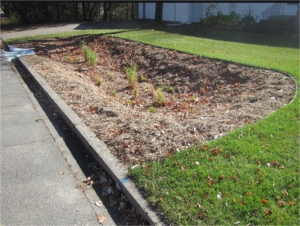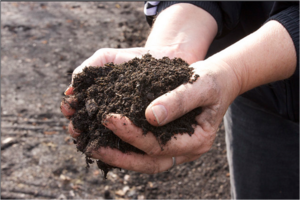
Difference between revisions of "Minnesota Stormwater Manual test page 5"
m |
m |
||
| Line 6: | Line 6: | ||
Given the lack of a consistent approach in stormwater pretreatment sizing, analysis was conducted to determine the general guidelines for pretreatment sizing in Minnesota based on the <span title="The rate at which suspended solids subside and are deposited."> '''settling velocity'''</span> of particles in stormwater. Many sizes of suspended solids enter a treatment practice–from clays below 2 μm (2 micrometers or 2000 mm) to silts between 2 μm and 80 μm to sands between 80 μm and 4 mm and beyond. A four order of magnitude difference between the smallest clay particles and largest sand sizes particles entering the practice is noted with a greater order of magnitude difference in settling velocity. A pretreatment practice is designed to settle the largest of these (primarily inorganic) particles in a location where they will be relatively simple to clean out and dispose of. As a result of this pretreatment, required maintenance will be reduced on the primary treatment practice (also called a <span title="a stationary and permanent BMP that is designed, constructed and operated to prevent or reduce the discharge of pollutants in stormwater"> '''structural stormwater BMP'''</span>) because a large portion of the <span title="small solid particles which remain in suspension in water as a colloid or due to the motion of the water,suspended solids can be removed by the sedimentation because of their comparatively large size."> '''suspended solids'''</span> will settle in the pretreatment practice, which will prolong the life span and maintain the design pollutant <span title="Pollutant removal efficiency, usually represented by a percentage, specifically refers to the pollutant reduction from the inflow to the outflow of a system"> '''removal efficiency'''</span> of the primary treatment. | Given the lack of a consistent approach in stormwater pretreatment sizing, analysis was conducted to determine the general guidelines for pretreatment sizing in Minnesota based on the <span title="The rate at which suspended solids subside and are deposited."> '''settling velocity'''</span> of particles in stormwater. Many sizes of suspended solids enter a treatment practice–from clays below 2 μm (2 micrometers or 2000 mm) to silts between 2 μm and 80 μm to sands between 80 μm and 4 mm and beyond. A four order of magnitude difference between the smallest clay particles and largest sand sizes particles entering the practice is noted with a greater order of magnitude difference in settling velocity. A pretreatment practice is designed to settle the largest of these (primarily inorganic) particles in a location where they will be relatively simple to clean out and dispose of. As a result of this pretreatment, required maintenance will be reduced on the primary treatment practice (also called a <span title="a stationary and permanent BMP that is designed, constructed and operated to prevent or reduce the discharge of pollutants in stormwater"> '''structural stormwater BMP'''</span>) because a large portion of the <span title="small solid particles which remain in suspension in water as a colloid or due to the motion of the water,suspended solids can be removed by the sedimentation because of their comparatively large size."> '''suspended solids'''</span> will settle in the pretreatment practice, which will prolong the life span and maintain the design pollutant <span title="Pollutant removal efficiency, usually represented by a percentage, specifically refers to the pollutant reduction from the inflow to the outflow of a system"> '''removal efficiency'''</span> of the primary treatment. | ||
| + | <div style="float:right" | ||
<table class="infobox" style="text-align: right; width: 300px; font-size: 100%"> | <table class="infobox" style="text-align: right; width: 300px; font-size: 100%"> | ||
<tr> | <tr> | ||
| Line 21: | Line 22: | ||
</tr> | </tr> | ||
</table> | </table> | ||
| + | </div> | ||
Initial research was conducted to determine whether an approach for {{pop|'''sizing'''|What is sizing?|Sizing typically refers to the volume of stormwater runoff and/or the amount of pollutant a specific structural best management practice (BMP) is designed to retain or treat. This volume or pollutant amount is often called a performance goal. As an example, consider a BMP designed to capture the first inch of runoff from one acre of impervious surface. This BMP must be sized to capture 3630 cubic feet of water. Sizing can be related to physical dimensions, such as the depth and surface area of a BMP, but may also be related to a volume passing through the BMP or the amount of material needed to provide a specific pollutant treatment.}} <span title="Pretreatment reduces maintenance and prolongs the lifespan of structural stormwater BMPs by removing trash, debris, organic materials, coarse sediments, and associated pollutants prior to entering structural stormwater BMPs. Implementing pretreatment devices also improves aesthetics by capturing debris in focused or hidden areas. Pretreatment practices include settling devices, screens, and pretreatment vegetated filter strips."> [https://stormwater.pca.state.mn.us/index.php?title=Pretreatment '''pretreatment''']</span> practices was consistently applied across the country. Stormwater programs for every state were reviewed to determine the approaches being used, as well as a consensus in the approach. The results of this review indicated that a consistent approach to stormwater pretreatment across the country was not used, and some states do not require pretreatment of stormwater runoff at all. Because of the lack of consensus and research-backed sizing criteria for pretreatment, stormwater practitioners in Minnesota determined that guidelines were needed to define specific sizing criteria to provide consistent, effective results. | Initial research was conducted to determine whether an approach for {{pop|'''sizing'''|What is sizing?|Sizing typically refers to the volume of stormwater runoff and/or the amount of pollutant a specific structural best management practice (BMP) is designed to retain or treat. This volume or pollutant amount is often called a performance goal. As an example, consider a BMP designed to capture the first inch of runoff from one acre of impervious surface. This BMP must be sized to capture 3630 cubic feet of water. Sizing can be related to physical dimensions, such as the depth and surface area of a BMP, but may also be related to a volume passing through the BMP or the amount of material needed to provide a specific pollutant treatment.}} <span title="Pretreatment reduces maintenance and prolongs the lifespan of structural stormwater BMPs by removing trash, debris, organic materials, coarse sediments, and associated pollutants prior to entering structural stormwater BMPs. Implementing pretreatment devices also improves aesthetics by capturing debris in focused or hidden areas. Pretreatment practices include settling devices, screens, and pretreatment vegetated filter strips."> [https://stormwater.pca.state.mn.us/index.php?title=Pretreatment '''pretreatment''']</span> practices was consistently applied across the country. Stormwater programs for every state were reviewed to determine the approaches being used, as well as a consensus in the approach. The results of this review indicated that a consistent approach to stormwater pretreatment across the country was not used, and some states do not require pretreatment of stormwater runoff at all. Because of the lack of consensus and research-backed sizing criteria for pretreatment, stormwater practitioners in Minnesota determined that guidelines were needed to define specific sizing criteria to provide consistent, effective results. | ||
Revision as of 14:07, 3 October 2019
Initial research was conducted to determine whether an approach for sizing pretreatment practices was consistently applied across the country. Stormwater programs for every state were reviewed to determine the approaches being used, as well as a consensus in the approach. The results of this review indicated that a consistent approach to stormwater pretreatment across the country was not used, and some states do not require pretreatment of stormwater runoff at all. Because of the lack of consensus and research-backed sizing criteria for pretreatment, stormwater practitioners in Minnesota determined that guidelines were needed to define specific sizing criteria to provide consistent, effective results.
Given the lack of a consistent approach in stormwater pretreatment sizing, analysis was conducted to determine the general guidelines for pretreatment sizing in Minnesota based on the settling velocity of particles in stormwater. Many sizes of suspended solids enter a treatment practice–from clays below 2 μm (2 micrometers or 2000 mm) to silts between 2 μm and 80 μm to sands between 80 μm and 4 mm and beyond. A four order of magnitude difference between the smallest clay particles and largest sand sizes particles entering the practice is noted with a greater order of magnitude difference in settling velocity. A pretreatment practice is designed to settle the largest of these (primarily inorganic) particles in a location where they will be relatively simple to clean out and dispose of. As a result of this pretreatment, required maintenance will be reduced on the primary treatment practice (also called a structural stormwater BMP) because a large portion of the suspended solids will settle in the pretreatment practice, which will prolong the life span and maintain the design pollutant removal efficiency of the primary treatment.
<div style="float:right"
|
Initial research was conducted to determine whether an approach for sizing pretreatment practices was consistently applied across the country. Stormwater programs for every state were reviewed to determine the approaches being used, as well as a consensus in the approach. The results of this review indicated that a consistent approach to stormwater pretreatment across the country was not used, and some states do not require pretreatment of stormwater runoff at all. Because of the lack of consensus and research-backed sizing criteria for pretreatment, stormwater practitioners in Minnesota determined that guidelines were needed to define specific sizing criteria to provide consistent, effective results.
Given the lack of a consistent approach in stormwater pretreatment sizing, analysis was conducted to determine the general guidelines for pretreatment sizing in Minnesota based on the settling velocity of particles in stormwater. Many sizes of suspended solids enter a treatment practice–from clays below 2 μm (2 micrometers or 2000 mm) to silts between 2 μm and 80 μm to sands between 80 μm and 4 mm and beyond. A four order of magnitude difference between the smallest clay particles and largest sand sizes particles entering the practice is noted with a greater order of magnitude difference in settling velocity. A pretreatment practice is designed to settle the largest of these (primarily inorganic) particles in a location where they will be relatively simple to clean out and dispose of. As a result of this pretreatment, required maintenance will be reduced on the primary treatment practice (also called a structural stormwater BMP) because a large portion of the suspended solids will settle in the pretreatment practice, which will prolong the life span and maintain the design pollutant removal efficiency of the primary treatment.
Stormwater and soil, engineered (bioretention) media, and media amendments


Soil and engineered media, often referred to as bioretention media, are fundamental design characteristics of most post-construction stormwater practices. In some applications, soil or media amendments are utilized to improve soil conditions or enhance treatment effectiveness of a BMP.
This page provides links to pages that address topics related to soil, engineered media, and soil/media amendments.
- Media
- Overview of engineered (bioretention) media
- Engineered (bioretention) media materials specifications
- Stormwater engineered (bioretention) media mixes
- Engineered (bioretention) media applications for stormwater BMPs
- Phosphorus leaching, export, and retention in engineered (bioretention) stormwater media
- Review and summary of literature pertaining to engineered (bioretention) media
- Engineered (bioretention) media selection tool
- Amendments
- Soil
- Vegetation
- Links
- Photo gallery for Stormwater and soil, engineered (bioretention) media, and media amendments
- Interesting websites